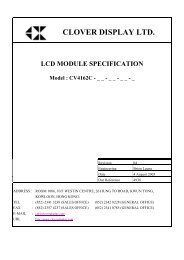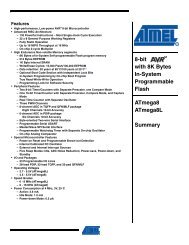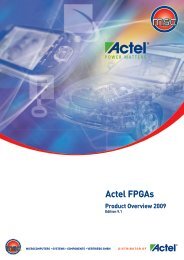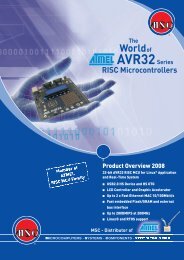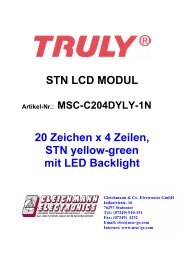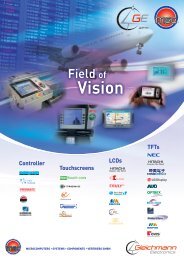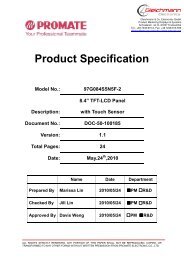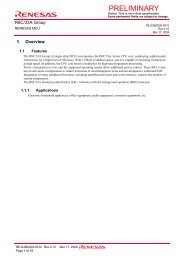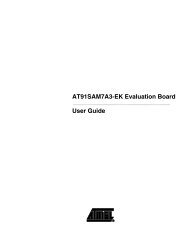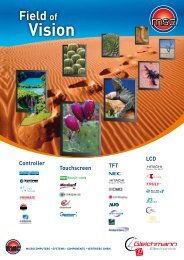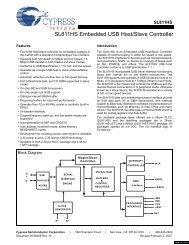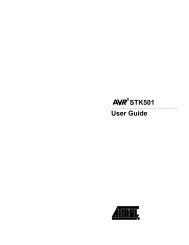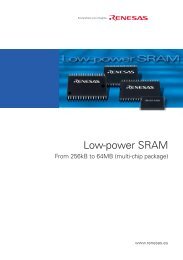TRS Star CompactFlash Card Industrial-Grade Datasheet
TRS Star CompactFlash Card Industrial-Grade Datasheet
TRS Star CompactFlash Card Industrial-Grade Datasheet
- No tags were found...
You also want an ePaper? Increase the reach of your titles
YUMPU automatically turns print PDFs into web optimized ePapers that Google loves.
<strong>Industrial</strong>-<strong>Grade</strong> <strong>CompactFlash</strong> <strong>Card</strong><strong>TRS</strong> <strong>Star</strong> SpecificationFor more information visit us under:http://www.trs-star.com4.3 Memory Mapped AddressingWhen the <strong>CompactFlash</strong> Memory <strong>Card</strong> registers are accessed via memory references, the registersappear in the common memory space window: 0-2K bytes as shown in Table 4.3Table 4.3 Memory Mapped Decoding-REG A10 A9-4 A3 A2 A1 A0 Offset -OE=0 -WE=0 Notes1 0 X 0 0 0 0 0 Even RD Data Even WR Data 11 0 X 0 0 0 1 1 Error Features 21 0 X 0 0 1 0 2 Sector Count Sector Count1 0 X 0 0 1 1 3 Sector No. Sector No.1 0 X 0 1 0 0 4 Cylinder Low Cylinder Low1 0 X 0 1 0 1 5 Cylinder High Cylinder High1 0 X 0 1 1 0 6 Select <strong>Card</strong>/Head Select <strong>Card</strong>/Head1 0 X 0 1 1 1 7 Status Command1 0 X 1 0 0 0 8 Dup. Even RD DataDup. Even WRData1 0 X 1 0 0 1 9 Dup. Odd RD Data Dup. Odd WR Data 21 0 X 1 1 0 1 D Dup. Error Dup. Features 21 0 X 1 1 1 0 E Alt Status Device Ctl1 0 X 1 1 1 1 F Drive Address Reserved1 1 X X X X 0 8 Even RD Data Even WR Data 31 1 X X X X 1 9 Odd RD Data Odd WR Data 32NOTES: 1. Register 0 is accessed with -CE1 low and -CE2 low as a word register on the combined Odd DataBus and Even Data Bus (D15-D0). This register may also be accessed by a pair of byte accesses tothe offset 0 with -CE1 low and -CE2 high. Note that the address space of this word register overlapsthe address space of the Error and Feature byte-wide registers that lie at offset 1. When accessedtwice as byte register with -CE1 low, the first byte to be accessed is the even byte of the word and thesecond byte accessed is the odd byte of the equivalent word access. A byte access to address 0 with -CE1 high and -CE2 low accesses the error (read) or feature (write) register.2. Registers at offset 8, 9 and D are non-overlapping duplicates of the registers at offset 0 and 1.Register 8 is equivalent to register 0, while register 9 accesses the odd byte. Therefore, if the registersare byte accessed in the order 9 then 8 the data will be transferred odd byte then even byte. Repeatedbyte accesses to register 8 or 0 will access consecutive (even then odd) bytes from the data buffer.Repeated word accesses to register 8, 9 or 0 will access consecutive words from the data buffer.Repeated byte accesses to register 9 are not supported. However, repeated alternating byte accessesto registers 8 then 9 will access consecutive (even then odd) bytes from the data buffer. Byteaccesses to register 9 access only the odd byte of the data.3. Accesses to even addresses between 400h and 7FFh access register 8. Accesses to oddaddresses between 400h and 7FFh access register 9. This 1 KByte memory window to the dataregister is provided so that hosts can perform memory to memory block moves to the data registerwhen the register lies in memory space. Some hosts, such as the X86 processors, must incrementboth the source and destination addresses when executing the memory to memory block moveinstruction. Some PC <strong>Card</strong> socket adapters also have auto incrementing address logic embeddedwithin them. This address window allows these hosts and adapters to function efficiently. Note that thisentire window accesses the Data Register FIFO and does not allow random access to the data bufferwithin the <strong>CompactFlash</strong> Memory <strong>Card</strong>.<strong>TRS</strong>* Tele-Radio-Space GmbH, reserves the right Page 45 from 113 <strong>Industrial</strong>-<strong>Grade</strong> <strong>CompactFlash</strong> <strong>Card</strong>to change products or specifications without notice. Rev. 1.4 Stand 06/2006



